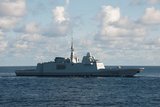EDA's SATCOM pooling project enters next phase
The European Defence Agency’s (EDA's) Governmental Satellite Communications (GOVSATCOM) Pooling and Sharing Demonstration project entered into the execution phase on 15 January.
The project is now ready to provide GOVSATCOM services to member states and the European Common Security and Defence Policy members through pooled capabilities (including bandwidth/power and/or services) provided by contributing member states. This pooled capability is set up to provide SATCOM resources that cannot be obtained on the commercial market with sufficient level of guaranteed access and security.
The project complements the EDA’s EU Satcom Market project, already in place since 2012, which provides commercially available SATCOM and CIS services.
SATCOM is rapidly deployable, flexible and distance insensitive and can offer communication links where terrestrial networks are damaged, overloaded or non-existent. However, access to SATCOM cannot be taken for granted at any time, especially not when governmental users require them at short notice and without pre-arranged agreements. In situations of high demand, competition with other users of commercial SATCOM capacities creates a risk of non-availability and high costs. Against this backdrop, EU leaders decided in 2013 that there was a need for a new solution combining the advantages of commercial and military satellite systems in order to address both civil and military needs through European cooperation.
Under the project led by Spain, all 15 contributing EDA member states (Spain, Austria, Belgium, Germany, Estonia, Greece, France, Italy, Latvia, Lithuania, Luxembourg, Poland, Portugal, Sweden and the UK) accepted the project arrangement as baseline for mutual support and collaboration. Norway is also contributing to the project.
The project is a collaborative effort between the EDA, the European Commission and the European Space Agency.
More from Digital Battlespace
-
![Babcock nears first customer for Nomad AI translation tool]()
Babcock nears first customer for Nomad AI translation tool
Nomad can provide militaries with real-time intelligence, saving critical time on the battlefield.
-
![AUSA 2025: Israel’s Asio Technologies to supply hundreds of improved Taurus tactical systems]()
AUSA 2025: Israel’s Asio Technologies to supply hundreds of improved Taurus tactical systems
Taurus operates alongside the Israel Defense Forces’ Orion system which supports mission management across tens of thousands of manoeuvring forces, from squad leaders to battalion commanders.
-
![AUSA 2025: Kopin pushes micro-LED plans as China moves faster]()
AUSA 2025: Kopin pushes micro-LED plans as China moves faster
The plan for the new displays follows fresh investment in Kopin’s European facilities by Theon and an order for head-up displays in fielded aircraft, with funding from the US Department of Defense.
-
![AUSA 2025: Persistent Systems to complete its largest order by year’s end]()
AUSA 2025: Persistent Systems to complete its largest order by year’s end
Persistent Systems received its largest ever single order for its MPU5 devices and other systems earlier this month and has already delivered the 50 units to the US Army’s 4th Infantry Division.
-
![Aselsan brings in dozens of companies and systems under the Steel Dome umbrella]()
Aselsan brings in dozens of companies and systems under the Steel Dome umbrella
Turkey has joined the family of countries attempting to establish a multilayered air defence system with government approval in August 2024 for the effort landed by Aselsan. Dubbed Steel Dome, the programme joins Israel’s Iron Dome, the US Golden Dome, India’s Mission Sudarshan Chakra and South Korea’s low-altitude missile defence system.
-
![DSEI 2025: MARSS unveils new agnostic multidomain C4 system]()
DSEI 2025: MARSS unveils new agnostic multidomain C4 system
MARSS’ NiDAR system has been deployed using sensors from static platforms to provide detection and protection for static sights, such as critical infrastructure, ports and military bases.




























